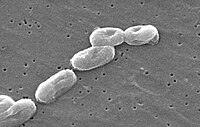
Photo from wikipedia
Carbapenem resistant Enterobacteriaceae (CRE) are a growing threat worldwide. Infections caused by these organisms have exhibited high rates of mortality (50%) for which there is no standard of care and… Click to show full abstract
Carbapenem resistant Enterobacteriaceae (CRE) are a growing threat worldwide. Infections caused by these organisms have exhibited high rates of mortality (50%) for which there is no standard of care and a dearth of clinical trials. Most in vitro data on CRE focus on Klebsiella pneumoniae, but it is known that effective therapy may depend on species or even strain. To address this, meropenem, amikacin, and polymyxin B alone and in combination were evaluated by time kill against four carbapenem-producing Enterobacter cloacae clinical isolates representing a range of meropenem nonsusceptibility (2-32 mg/L) and resistance mechanisms (KPC 2 and/or VIM 1). As meropenem minimum inhibitory concentration (MIC) increased, bactericidal activity and synergy were maintained for 48 hours in isolates exposed to meropenem and amikacin, but synergy and bactericidal activity were not maintained in all isolates exposed to meropenem and polymyxin B.
Journal Title: Diagnostic microbiology and infectious disease
Year Published: 2018
Link to full text (if available)
Share on Social Media: Sign Up to like & get
recommendations!